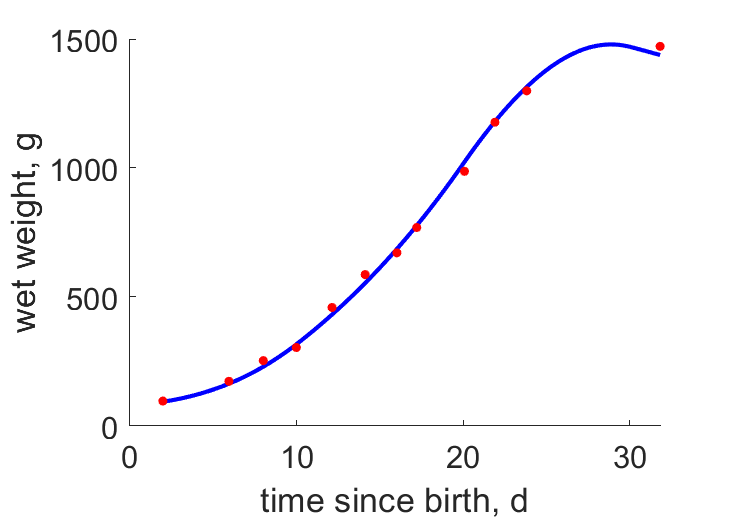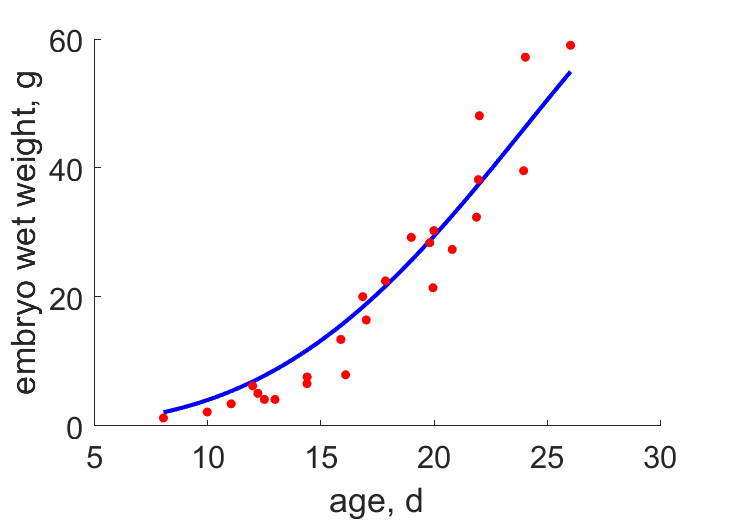Predictions & Data for this entry
| Model: std | climate: MC | migrate: Ml | phylum: |
| COMPLETE = 2.9 | ecozone: MAN | food: biCvf, biCi, biSi, biSv | class: |
| MRE = 0.054 | habitat: 0iMm, biMc | gender: Dg | order: |
| SMSE = 0.009 | embryo: Tnsfm | reprod: O | family: |
Zero-variate data
| Data | Observed | Predicted | (RE) | Unit | Description | Reference |
|---|---|---|---|---|---|---|
| ab | 27 | 29.81 | (0.1043) | d | age at birth | AnAge |
| tx | 52 | 51.93 | (0.001372) | d | time since birth at fledging | avibase |
| tp | 156 | 140.2 | (0.1015) | d | time since birth at puberty | guess |
| tR | 1825 | 1825 | ( 0) | d | time since birth at 1st brood | AnAge |
| am | 1.197e+04 | 1.196e+04 | (0.0006971) | d | life span | AnAge |
| Ww0 | 116.5 | 109.8 | (0.0574) | g | initital wet weight | avibase |
| Wwb | 80 | 80.96 | (0.01194) | g | wet weight at birth | Harr1964 |
| Wwi | 1407 | 1455 | (0.03429) | g | ultimate wet weightof females | avibase |
| Wwim | 1806 | 1803 | (0.001891) | g | ultimate wet weight of males | avibase |
| Ri | 0.007671 | 0.00743 | (0.03146) | #/d | maximum reprod rate | avibase |
Uni- and bivariate data
| Data | Figure | Independent variable | Dependent variable | (RE) | Reference |
|---|---|---|---|---|---|
| tW |  | time since birth | wet weight | (0.02646) | Harr1964 |
| tWe |  | age | embryo wet weight | (0.1801) | Harr1964 |
Pseudo-data at Tref = 20°C
| Data | Generalised animal | Larus marinus | Unit | Description |
|---|---|---|---|---|
| v | 0.02 | 0.03685 | cm/d | energy conductance |
| p_M | 18 | 889.9 | J/d.cm^3 | vol-spec som maint |
| k_J | 0.002 | 0.03818 | 1/d | maturity maint rate coefficient |
| k | 0.3 | 0.3134 | - | maintenance ratio |
| kap | 0.8 | 0.9093 | - | allocation fraction to soma |
| kap_G | 0.8 | 0.8018 | - | growth efficiency |
| kap_R | 0.95 | 0.95 | - | reproduction efficiency |
Discussion
- Feeding is slightly reduced towards end of nestling period
- Long tp cannot be captured by std model
- males are assumed to differ from females by {p_Am} only
- mod_1: Pseudo-data point k is used, rather than k_J; Data set tp and parameter t_R are added, the latter replacing clutch interval t_N. Postnatal T is based on PrinPres1991, see get_T_Aves. See further the revision page, theme puberty
Bibliography